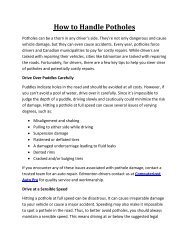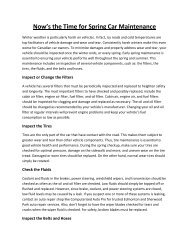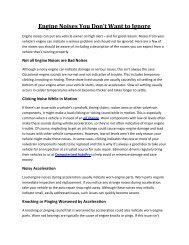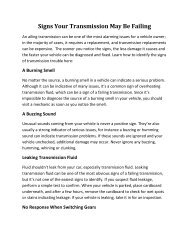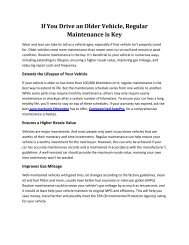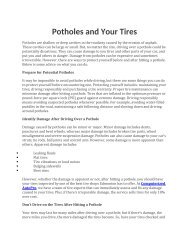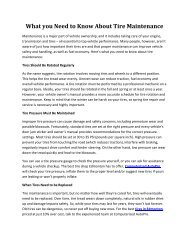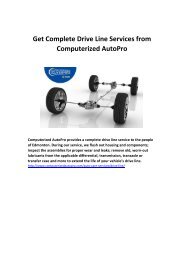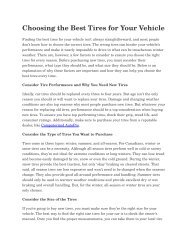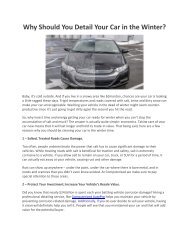Buying Used Tires: Should You or Shouldn’t You?
Some people prefer buying used tires for their vehicle as new tires can be expense. Choosing used tires, however, can be a mistake. It’s recommended that you inspect the used tires from any trusted auto repair shop like Computerized AutoPro, to determine if they are going to perform best for your vehicle.
Some people prefer buying used tires for their vehicle as new tires can be expense. Choosing used tires, however, can be a mistake. It’s recommended that you inspect the used tires from any trusted auto repair shop like Computerized AutoPro, to determine if they are going to perform best for your vehicle.
- TAGS
- tire-shops-edmonton
Create successful ePaper yourself
Turn your PDF publications into a flip-book with our unique Google optimized e-Paper software.
<strong>Buying</strong> <strong>Used</strong> <strong>Tires</strong>: <strong>Should</strong> <strong>You</strong> <strong>or</strong> <strong>Should</strong>n’t <strong>You</strong>?<br />
<strong>Buying</strong> used tires is not uncommon f<strong>or</strong> vehicle owners on a budget. New tires are an expense, and one<br />
which may not have been planned if replacement is unexpected. Although this is an option, buying used<br />
tires to save money could be a mistake. Because they’re used, you won’t know their true condition,<br />
where they came from, how safe they are <strong>or</strong> how they were used. The tires could have been<br />
overinflated, underinflated, <strong>or</strong> driven in treacherous weather <strong>or</strong> road conditions. All of these things<br />
could lead to internal damage that the seller is unaware of <strong>or</strong> won’t warn you about. Learn the pitfalls of<br />
buying used tires:<br />
<strong>Tires</strong> Aren’t Inspected f<strong>or</strong> Internal Damage<br />
It’s impossible to check f<strong>or</strong> internal damage when shopping f<strong>or</strong> used tires – whether you buy them<br />
online <strong>or</strong> in-person. M<strong>or</strong>eover, most retailers don’t check f<strong>or</strong> <strong>or</strong> warn customers about possible inner<br />
tire damage. However, inner tire damage can be caused by a variety of things, including:<br />
<br />
<br />
<br />
Vehicle impacts that cause tread separation, weaken belts and c<strong>or</strong>ds <strong>or</strong> cause external bulges <strong>or</strong><br />
cuts<br />
Tiny pinholes that allow water to enter the inner tire<br />
Small shards of glass embedded in the tire rubber<br />
<strong>Used</strong> <strong>Tires</strong> May Have Old, W<strong>or</strong>n Rubber<br />
Like many things in life, rubber ages. After about five years, the compounds in tire rubber begin to dry<br />
out and deteri<strong>or</strong>ate. This can be caused by ozone, ultraviolet ray (UV ray), dust <strong>or</strong> salt exposure and<br />
m<strong>or</strong>e. Po<strong>or</strong> maintenance can exacerbate wear on the rubber <strong>or</strong> increase the aging process. <strong>Tires</strong> over<br />
the age of the five should be inspected annually, but this isn’t often the case with used tires.<br />
Bef<strong>or</strong>e buying a used tire, check the age on the four-digit Department of Transp<strong>or</strong>tation (DOT) date code<br />
within the tire’s sidewall. The first two numbers in the code indicate the week of manufacture, while the<br />
second two numbers indicate the year. F<strong>or</strong> example, 3216 means that a tire was manufactured in the<br />
32nd week of 2016.<br />
Of course, if you buy new tires from the best tire shop Edmonton has to offer – Computerized AutoPro<br />
– you won’t have to w<strong>or</strong>ry about aging <strong>or</strong> wear. Our shop sells tires at just 10% over cost, giving you the<br />
opp<strong>or</strong>tunity to save money and providing you with new, w<strong>or</strong>ry-free tires.<br />
They Aren’t Inspected f<strong>or</strong> Overall Damage<br />
Without a proper inspection, it’s impossible to determine the true condition of a used tire. These tires<br />
could possibly have a mountain of problems, including: cracks and dryness, improper repair, leading to<br />
anomalies <strong>or</strong> decreased perf<strong>or</strong>mance and excessive tread wear. However, an inspection could detect<br />
maj<strong>or</strong> and min<strong>or</strong> damage, preventing possible road accidents and the sale of recalled tires. Since proper<br />
inspections aren’t usually perf<strong>or</strong>med by used tire retailers, experts suggest you never by tires that have:
Exposed inner parts <strong>or</strong> c<strong>or</strong>ds<br />
No warranty <strong>or</strong> tire registration<br />
Less than 2/32” of tread<br />
Beads, tread shoulder <strong>or</strong> sidewall repairs<br />
A manufacturer’s recall<br />
Wide punctures<br />
Unclear <strong>or</strong> non-existent DOT code<br />
Any signs of damage, especially c<strong>or</strong>d, ply <strong>or</strong> tread separation<br />
Save a bundle on your brand new tires – contact us today to find the tires that are going to perf<strong>or</strong>m best<br />
f<strong>or</strong> your vehicle.




